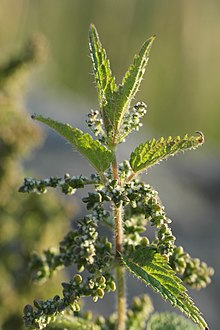
Back قراص كبير Arabic قراص كبير ARZ Urtica dioica AST İkievli gicitkan Azerbaijani Кесерткән Bashkir Lateng BAN Крапіва двухдомная Byelorussian Обикновена коприва Bulgarian Kopriva BS Ortiga gran Catalan
| Urtica dioica | |
|---|---|

| |
| Urtica dioica subsp. dioica | |
| Scientific classification | |
| Kingdom: | Plantae |
| Clade: | Tracheophytes |
| Clade: | Angiosperms |
| Clade: | Eudicots |
| Clade: | Rosids |
| Order: | Rosales |
| Family: | Urticaceae |
| Genus: | Urtica |
| Species: | U. dioica
|
| Binomial name | |
| Urtica dioica | |
Urtica dioica, often known as common nettle, burn nettle, stinging nettle (although not all plants of this species sting) or nettle leaf, or just a nettle or stinger, is a herbaceous perennial flowering plant in the family Urticaceae. Originally native to Europe, much of temperate Asia and western North Africa,[2] it is now found worldwide. The species is divided into six subspecies, five of which have many hollow stinging hairs called trichomes on the leaves and stems, which act like hypodermic needles, injecting histamine and other chemicals that produce a stinging sensation upon contact ("contact urticaria", a form of contact dermatitis).[3][4]
The plant has a long history of use as a source for traditional medicine, food, tea, and textile raw material in ancient (such as Saxon) and modern societies.[2][5]
- ^ Maiz-Tome, L. (2016). "Urtica dioica". IUCN Red List of Threatened Species. 2016: e.T167815A78457212. doi:10.2305/IUCN.UK.2016-1.RLTS.T167815A78457212.en. Retrieved 4 May 2024.
- ^ a b c Cite error: The named reference
POWO_260630-2was invoked but never defined (see the help page). - ^ "Nettles". Drugs.com. 2009. Retrieved 23 April 2018.
- ^ Per Brodal (2010). The Central Nervous System: Structure and Function. Oxford University Press US. p. 170. ISBN 978-0-19-538115-3. Retrieved 22 September 2010.
- ^ Lukešová, Hana (June 2017). "Identifying plant fibre textiles from Norwegian Merovingian Period and Viking Age graves: The Late Iron Age Collection of the University Museum of Bergen". Journal of Archaeological Science: Reports. 13: 281–285. Bibcode:2017JArSR..13..281L. doi:10.1016/j.jasrep.2017.03.051.
© MMXXIII Rich X Search. We shall prevail. All rights reserved. Rich X Search
